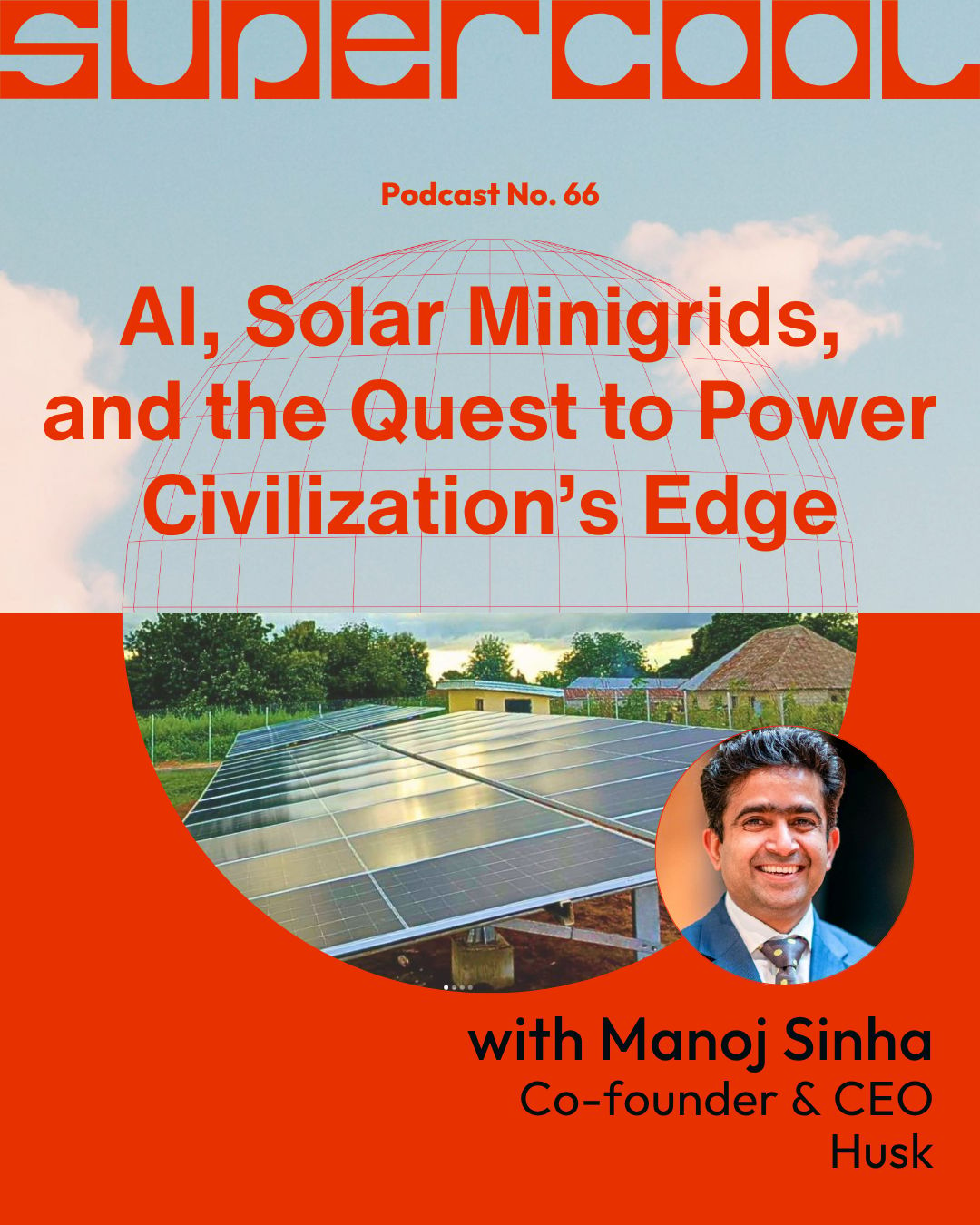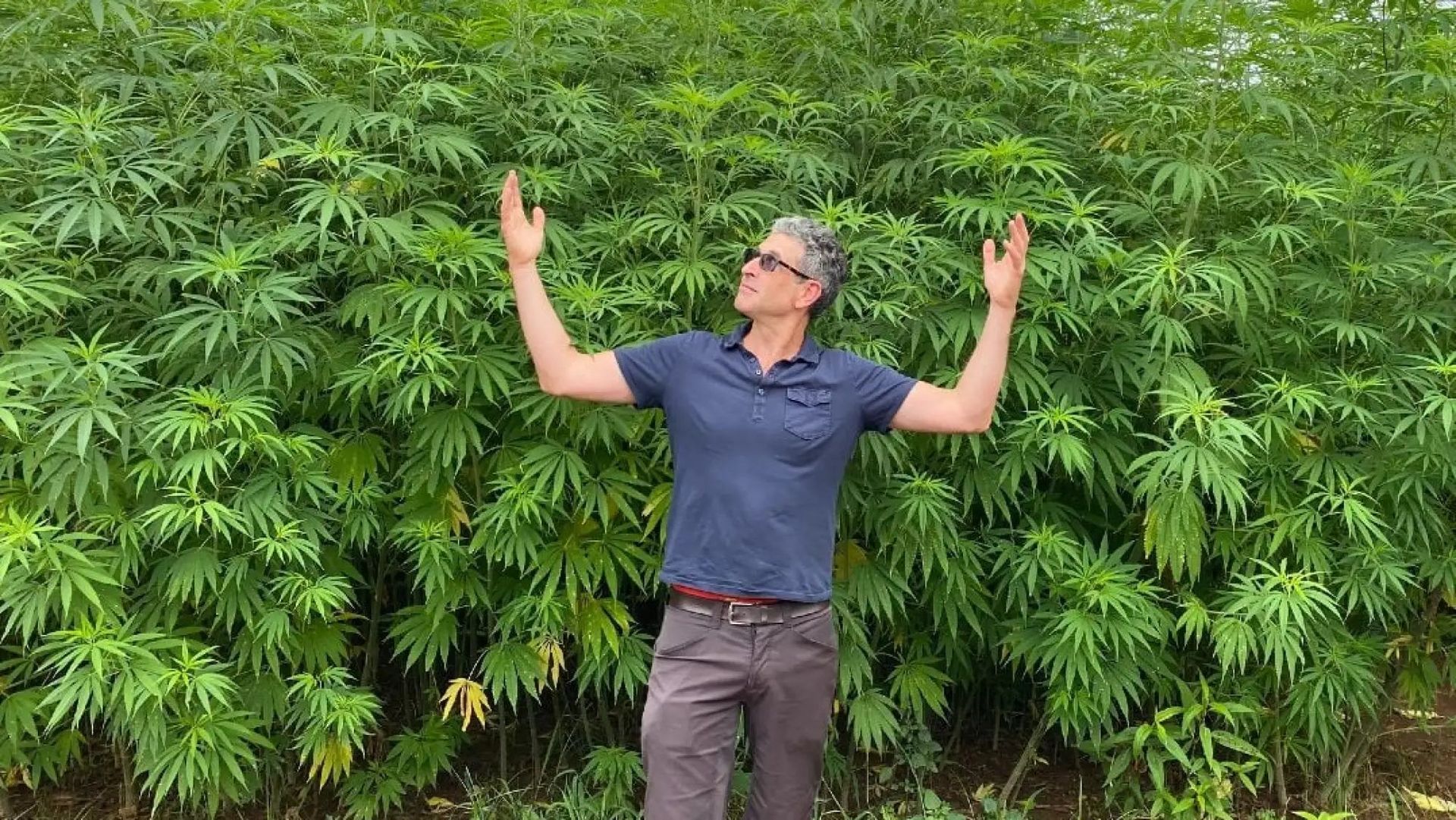- Supercool
- Posts
- 🌐 AI, Solar Minigrids, and the Quest to Power Civilization’s Edge
🌐 AI, Solar Minigrids, and the Quest to Power Civilization’s Edge
Husk is building the world’s first self-learning, clean-energy network—for the villages the grid forgot.
Adoption Archetype: 🧩 Friction Removal - Make it easier
“When a village lights up for the first time, you can see the future take shape right in front of you,” says Manoj Sinha, co-founder & CEO of Husk Power.
That first moment happened in Bihar, India. A villager stood beneath a string of bulbs, seeing electricity for the first time in his life. He turned to Manoj and said, some sixty years after India gained independence, this was his Independence Day—the day he was finally free from darkness.
That single exchange drives Husk’s mission: to make that moment repeatable—to bring clean, affordable energy to places the power grid has forgotten.
From Frugal Innovation to Hybrid Power
When Manoj launched Husk in 2008, solar energy cost $5 per watt.
So he built with what he had. Rice husks from local mills were used as biomass fuel. Wires were hung from makeshift bamboo poles. “We were inventing every part of the value chain,” Manoj says. “We had to, or nobody could afford the power.”

The first design of Husk’s minigrid in Bihar, India.
That instinct—to engineer from scarcity—became Husk’s advantage.
By 2015, as solar and batteries became viable, Husk transitioned to hybrid systems: solar during the day, batteries at night, and biomass for backup. Partnering with First Solar, the company delivered 24/7 clean power for the first time.
But operating hundreds of micro-utilities across unpredictable markets proved complex. Demand spiked at harvest, dropped during the monsoon season, and fluctuated with local economic activity.
Reliability required more than manpower. It required a new layer of intelligence.
Teaching the Grid to Think
In 2019, long before AI became a buzzword, Husk began teaching its minigrids to think.
“We were using AI before it was cool,” Manoj says. “Before anyone thought it could run power plants.”
Machine-learning algorithms began forecasting demand before it happened—deciding when to charge batteries, when to run biomass, when to conserve. Every data point made the next site smarter.
Automation reduced labor needs from two full-time operators per site to half a headcount, making it financially feasible to scale from hundreds to thousands of grids. Operating costs declined by 7% annually, despite inflation in India rising by 8%.
AI became the operating layer—learning from every site to make the next run smarter.
Then came the next leap. In 2024, Husk deployed generative AI that learns every thirty minutes how to optimize power flows in real-time.
In early pilots, it beat the company’s best engineers by more than 20%.
“I was upset,” Manoj laughs. “I thought I was a great engineer. But that’s when I knew this could scale to five thousand grids.”
Each installation now improves the next. The network doesn’t just supply energy—it evolves with experience.

Husk’s Prism “minigrid in a box” can be installed and fully operational within 24 hours.

It integrates solar, batteries, and backup biogas.
Power That Creates Prosperity
One hot afternoon, Manoj stopped for a Coke in a small shop. The owner handed him a warm bottle. “No refrigerator,” he said.
That moment refocused the mission. Power doesn’t create prosperity unless it drives productivity.
Husk began financing productive appliances—welders, lathes, cold storage units, and refrigerators—so customers could convert electricity into income. The company financed the first wave itself, proving the model before bringing in credit partners.
“The more productive the power, the cheaper it gets for everyone,” Manoj says.
Each grid becomes a self-reinforcing loop:
Productivity builds income
Income builds trust
Trust builds energy demand
That model works because Husk owns the entire value chain. The company builds, operates, and services every grid it installs. Customers prepay for electricity like topping up a mobile plan. Smart meters track usage. Local technicians run each site.
Manoj calls it “a modern utility with start-up reflexes.” Hybrid generation guarantees uptime. AI optimization keeps costs falling. Local ownership roots value in the community.
Each grid is a self-sustaining engine of growth—renewable, reliable, and profitable.
Where AI Meets the Edge
Husk’s network operates in places where the grid never arrived. Each new site becomes a node in its own learning web—data from one village improving operations in another, insights from India informing microgrids in Nigeria.
AI now links hundreds of independent grids into a single, self-learning network—an operating system for clean energy at the frontier.
That same intelligence is now moving beyond the village. Earlier this year, Husk launched Beem, leveraging its AI optimization, predictive maintenance, and customer financing solutions for home solar.
And with a rare promise: if a system underperforms, Husk refunds the customer.
“AI runs so precisely,” Manoj says, “that we can guarantee what every rooftop will generate.”

A Beem home solar unit.
By 2030, Husk is targeting 1 million home solar systems and 5,000 minigrids—that’s over four gigawatts of power serving more than 100 million people, creating 50,000 jobs, powering 200,000 small enterprises, and cutting tens of megatons of CO₂.
For Manoj, reliable power isn’t just electricity; it’s the entranceway to modern life.
🌐 Supercool Takeaway
Husk isn’t just operating at the grid’s edge—it’s operating at civilization’s edge. It proves that autonomous clean energy systems can operate reliably in areas where the traditional grid has never reached. What that unlocks is profound: affordable, always-on power that raises living standards, fuels local enterprise, and shows how clean energy can scale anywhere.
Operator Takeaways:
Learning compounds scale. Each grid improves the next, multiplying efficiency.
Economic value sustains adoption. When clean power helps people earn a living, they continue to use and pay for it.
Vertical integration enables scale. Novel climate solutions often require full control to align economic and operational incentives.
This Week’s Podcast Episode
AI, Solar Minigrids, and the Quest to Power Civilization’s Edge
🎙️ Listen on Apple, Spotify, YouTube, and all other platforms.

↓
Stat of the Week: 6x
That’s the gap between the cost of installing rooftop solar in India and in the United States.
In India, residential systems run $540–$900 per kilowatt. In the U.S., they average $2,500–$3,500.
Same panels. Same sun. But wildly different economics—driven not by technology, but by soft costs: permitting, financing, and customer acquisition. In India, those layers barely exist. In the U.S., they’re more than half the bill.
Quote of the Week:
We have really created a new asset class that the world has now taken cognizance of — it has become a mainstream way of electrifying the lives of the next billion people.
↓
🌐 The Climate Adoption Playbook - Module 1
There’s no shortage of climate solutions that work. The challenge is getting people to use them. The tech performs. The impact is proven. But between performance and adoption lies a gap — often the unseen friction that keeps customers and markets from saying yes.
When it comes to electrification, Copper saw the real barrier. The company builds induction ranges with built-in batteries that plug into a standard outlet.

They understood that enthusiasm for cooking on induction wasn’t the problem — wiring was. Most homes need an electrical panel upgrade and a new 240V outlet in the kitchen before they can switch away from gas, a hidden cost that can run into the thousands.
So Copper eliminated the friction. By embedding battery storage directly into its appliances, Copper enables instant installation and cooking. New ranges plug into the same outlet as the toaster. No electrician. No costly upgrades. Now it’s easy for customers to say yes.
That’s how adoption happens—when climate solutions stop asking customers to adapt and instead adapt to them.
From the Climate Adoption Playbook — learn how climate solutions gain mass adoption.
↓
AI For Climate is Here.
AI for climate is here. It’s powering the next generation of practical solutions—cutting emissions in how we move, build, and live. While much of the attention is on AI’s energy use, companies have already begun using it to build a better, higher-quality, lower-carbon future.
Zum — Mobility (newsletter / podcast)
Zum utilizes AI to plan and optimize electric bus routes for 27 million students across over 4,000 schools nationwide, replacing diesel fleets with zero-emission vehicles and implementing predictive scheduling that minimizes idle time and charging needs. The platform tracks every route, battery, and driver in real time, helping school districts cut emissions, reduce costs, and maintain on-time performance above 98%.
Veo — Micromobility (coming next week)
Veo applies AI and computer vision to manage shared e-scooters and e-bikes, predicting demand by block and time of day. Its models reduce rebalancing trips by up to 40% and direct chargers to the right locations, cutting operational emissions while keeping vehicles available where riders need them most.
BrainBox AI — Buildings (newsletter / podcast)
BrainBox AI utilizes predictive algorithms to train HVAC systems to anticipate demand and adjust in real-time. The platform directly connects to building controls, modeling thermal behavior to reduce energy use by up to 25% and carbon emissions by as much as 40%.
Envac — Waste (newsletter / podcast)
Envac uses AI to manage automated underground waste collection, moving trash through pneumatic tubes instead of trucks. Algorithms track capacity, timing, and flow to trigger collection only when needed, cutting transport emissions by as much as 90% in dense cities.
Wasteless — Food Systems (newsletter / podcast)
Wasteless utilizes AI to dynamically price groceries based on expiration dates, inventory levels, and demand. Its algorithms adjust prices in real-time to nudge shoppers toward items that would otherwise go to waste, reducing spoilage by up to half.
Quilt — Homes (coming soon)
Quilt’s AI-driven heat-pump system personalizes comfort room by room. Sensors detect occupancy, learn temperature preferences, and deliver energy only where it’s needed, lowering household emissions and bills simultaneously.
Cambium — Materials (newsletter / podcast)
Cambium utilizes machine learning to analyze salvaged wood, scanning each piece to identify its species, grade, and potential for reuse. The system converts waste streams into a reliable source of low-carbon building materials, helping circular construction scale through precision and data-driven insights.
Camus Energy — Energy Grids (newsletter / podcast)
Camus Energy uses AI to coordinate distributed energy resources across power grids—from EVs to rooftop solar—to reduce fossil backup generation. The software predicts demand, balances the energy load in real-time, and helps utilities run more sustainably and efficiently.
Together, these companies show how AI is already driving measurable carbon reduction across nearly every part of the clean energy transition.
↓
Where Supercool traveled this week:
Collision - Eight Questions with Josh Dorfman

“Josh Dorfman was never supposed to get into real estate; Josh Dorfman was going to be a spy.”
And so begins my conversation with Daniel Schmergel.
↓
Interested in Advertising with Supercool?
Connect with future-forward decision-makers seeking next-gen climate innovations. Reach out to discuss how Supercool’s platform can help. Just hit reply to this email.
↓
Not yet subscribed to Supercool?
Click the button below for weekly updates on real-world climate solutions that cut carbon, boost the bottom line, and improve modern life.
🌐
